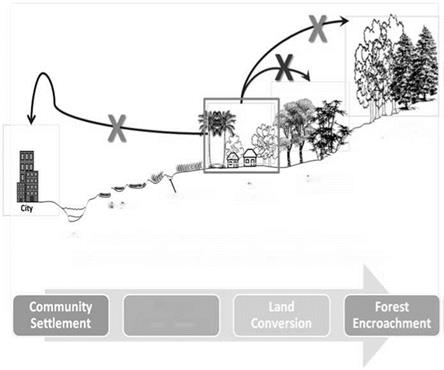The landscape ecology-based approach focuses on three aspects: structure, function, and change (Forman and Godron 1986). The fourth aspect, which was added lately, is culture. These four aspects were elaborated into the homegardens concept as an ecological process in human activities. Recently, encroaching on the forest is a major problem for some local governments in Indonesia. Therefore, to reduce forest encroachment and at the same time conserve protected areas, the pekarangan system should be revitalized. When communities can obtain some benefits from their pekarangan, they may avoid destroying the forest areas. They can manage the pekarangan area intensively and obtain some income to fulfill their needs (Fig. 17.1).
The terminology of pekarangan is now used widely in much scientific research, particularly in agroforestry and environment-related areas. Pekarangan can be viewed as a reconstruction of a complex tropical forest ecosystem consisting of useful flora and fauna, which also has the attribute of doing minimal harm to the environment (Takeuchi 2010). As traditional homegardens in Indonesia, pekarangan has an important role in building a low carbon society (LCS). To conserve protected areas, pekarangan could be one solution to keep people in their village. It means people will not encroach on the forest to seek more income because they can obtain it from their pekarangan. A large number of pekarangan in Indonesia are a potential source of carbon sequestration and maintenance of stock. In addition, it provides additional income for the households.
In the effort to rebuild sustainable local societies, the current circumstances in which pekarangan systems are contributing to environmental diversity and community incomes in the face of massive urban and rural development are a concern. Pekarangan reflects the behavior of its ownership; it has a strong relationship to human activities. As stated by Harashina et al. (2003), human activities cause
![]()
 Small-scale Agroforestry Systems, called as рекагапдап.
Small-scale Agroforestry Systems, called as рекагапдап.
It could be one of solutions in order to keep forest more sustain.
Forest
Dependency
Fig. 17.1 Pekarangan can be one solution to keep protected areas more sustainable. People are used to immigrating to urban areas or converting land use or encroaching on forest areas when their livelihood is threatened because of reduction of income, social status, and food for consumption
significant impact on nutrient flow. Soemarwoto (1984, 1987) also said that the pekarangan “definition” revolves around representative, intimate, multistory combinations of various tree and crops, sometimes in association with domestic animals around the homestead. Those pekarangan were categorized as either survival gardens or subsistence gardens based on the Wiersum (2006) classification adapted from Ninez (1984). There are also survival gardens, that are defined as a single component of the farming system of otherwise landless rural people and a combination of production from staple food crops and complementary crops. Subsistence gardens are part of a multicomponent farming system in conjunction with permanent or shifting field production and also a complementary system to open-field staple food cultivation systems. In this type of garden, daily household provision of vegetable, herbs, spices, and fruits for immediate needs and occasional sale is found.



